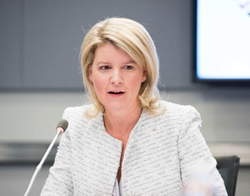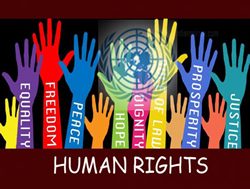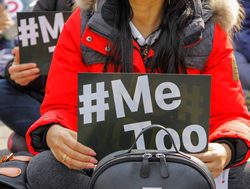Tania Penovic* examines Australia’s work over the past 29 years to eliminate all forms of discrimination against women.
 The Convention on the Elimination of All Forms of Discrimination against Women (CEDAW) was adopted by the UN General Assembly in 1979 and entered into force in September 1981.
The Convention on the Elimination of All Forms of Discrimination against Women (CEDAW) was adopted by the UN General Assembly in 1979 and entered into force in September 1981.
So it’s been up and running for a full four decades.
The Committee on the Elimination of Discrimination against Women was established under CEDAW to monitor its implementation.
Australia ratified the convention in 1983, and for the second time in the CEDAW committee’s history, an Australian is serving as one of its 23 expert members.
Natasha Stott Despoja (pictured) commenced her term in January 2021.
Her work will build on the important legacy of Elizabeth Evatt, who served on the committee from 1984 until 1992, chaired it from 1989-1991, and helped advance the understanding that gender-based violence is a violation of human rights.
The federal Minister for Women, Senator Marise Payne, has linked the government’s support for the election of an Australian to the committee to its “commitment to eliminating discrimination against women and girls in Australia and globally”.
Testing Australia’s commitment
So how committed is Australia to advancing the rights set out in CEDAW?
Our greatest achievement in this regard has been the passage of the Sex Discrimination Act 1984 (Cth) (SDA).
This was the late Senator Susan Ryan’s second legislative attempt to implement norms enshrined in CEDAW.
Its passage was the subject of prolonged debate and fierce contestation.
Hysterical pronouncements about the damage it would cause to the family, economy and Australian way of life were delivered in Parliament, on talkback radio, banners, newspaper advertisements and thousands of petitions delivered to parliamentarians.
In order to secure the bill’s passage, significant compromises were made, including exemptions for religious schools.
How does the Sex Discrimination Act relate to CEDAW?
The SDA seeks to give effect to some of CEDAW’s provisions in Australian law by, as far as possible, eliminating discrimination against persons on the basis of sex, marital status, pregnancy, potential pregnancy or family responsibility.
These protected grounds were expanded in 2013 to include relationship status, sexual orientation, gender identity and intersex status.
Unlawful discrimination under the SDA includes:
- treating a person less favourably (for example, dismissal from employment) on the basis of one of the protected grounds
- practices, conditions or requirements applicable to all but which have a discriminatory effect (for example, the requirement that all staff must work full-time)
- unwelcome conduct of a sexual nature, known as sexual harassment.
Tasked with advancing gender equality under the SDA and in accordance with CEDAW is the Sex Discrimination Commissioner, one of the seven commissioners of Australia’s national human rights institution, the Australian Human Rights Commission.
The commissioner’s role includes conciliating complaints of unlawful discrimination under the SDA, undertaking research, educational programs, advising government, and working with employers to promote gender equality.
Beyond the enactment of the SDA and creation of the office of the Sex Discrimination Commissioner, further advances in CEDAW’s implementation include Australia’s first national paid parental leave scheme, which provides certain eligible employees with up to 18 weeks’ paid parental leave, and legislation that establishes the Workplace Gender Equality Agency and requires certain employers to report annually on their progress in achieving gender equality.
A further achievement in the advancement of CEDAW lies in our foreign aid strategy under which at least 80 per cent of development investments are dedicated to gender issues, including violence against women, and women’s empowerment.
And despite its earlier refusal, Australia has ratified CEDAW’s Optional Protocol that provides an avenue for complaints alleging violations of CEDAW to be brought to the CEDAW Committee, and empowers the committee to conduct inquiries into allegations of grave or systematic violations.
The first complaint to be brought against Australian concerns the right to social security and family benefits, and now awaits the committee’s determination.
A final notable achievement in the advancement of gender equality lies in an area largely regulated by state and territory law – namely, access to abortion.
All states and territories have enacted legislation preventing the targeted harassment of persons attending clinics providing abortion services.
And while barriers to abortion access remain, abortion has been decriminalised nationwide, and is increasingly understood to be an issue of healthcare and gender equality rather than criminal law.
Despite these achievements, CEDAW remains only partially implemented in Australian law, and we’re yet to make significant progress in advancing gender equality.
In 2021, Australia dropped to 50th in the World Economic Forum’s Global Gender Gap Report.
This marks a significant drop from its rank of 15th in 2006, and contrasts starkly with New Zealand’s rank of fourth.
COVID-19 has exacerbated gender inequality and heightened the risk of gender-based violence.
And for women who experience intersecting forms of disadvantage and discrimination, including Aboriginal and Torres Strait Islander Women, CEDAW’s standards remain unfulfilled.
What remains to be done?
The CEDAW Committee and the Australian Human Rights Commission have done significant work in guiding Australia on what remains to be done to implement CEDAW and advance gender equality.
The CEDAW Committee has made numerous recommendations for change to Australian law and policy, but key recommendations have not been implemented.
These include:
- the adoption of a national human rights charter
- a guarantee of gender equality
- a comprehensive strategy to overcome discriminatory gender stereotypes; and
- the adoption of a range of measures in consultation with Aboriginal and Torres Strait Islander women.
The Australian Human Rights Commission’s work on addressing inequality has included Aboriginal and Torres Strait Islander Commissioner Dr June Oscar’s Wiyi Yani U Thangani (Women’s Voices) project, which charts the aspirations and needs of Aboriginal and Torres Strait Islander women and girls to provide guidance to government within a human rights framework.
Sex Discrimination Commissioner Kate Jenkins’ significant work into structural and systemic gender inequality includes:
- Respect@Work, the report of her national inquiry into workplace sexual harassment that made 55 recommendations for addressing workplace sexual harassment
- an independent review into Commonwealth parliamentary workplaces, which found that one in three people working in Commonwealth parliamentary workplaces had been sexually harassed, and that gender inequality was a key driver of bullying, sexual harassment and sexual assault in these work environments.
Although the government has committed to significant reforms in response to the Sex Discrimination Commissioner’s Respect@Work report, it’s failed to accept its most transformative recommendation, requiring positive measures from employers to eliminate sexual harassment, discrimination and victimisation.
While key recommendations by our national human rights body and the CEDAW Committee remain unimplemented, Australia cannot achieve the transformative change required to achieve gender equality.
*Tania Penovic, Senior Lecturer, Law Resources at Monash University.
This article first appeared at lens.monash.edu.











